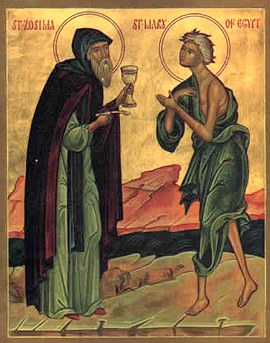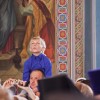Source: Coptic Orthodox Church Network
“O Lord, open Thou my lips. and my mouth shall show forth Thy praise”
Today, the Fifth Sunday in Lent, is for the Orthodox Church the Sunday of Saint Mary of Egypt – she whose story has been called “an icon in words of the theological truth of repentancc” (Sr. Bcnedicta Ward). We have heard this story many times. It is a simple one: the sinful woman becomes the penitent, and the least worthy is revealed as God’s chosen treasure. It offers us familiar words about the power of faith, and familiar inspiration in the heroic actions of St. Mary herself. But it is, above all, a disturbing story. In the end. it haunts me far more often than it comforts me. Today. I would like to explore where the heart of this story lies, and why it is given to us especially to remember it on the Fifth Sunday of Lent each year.
Three Stories
1. Mary’s Life
 The story of Mary of Egypt as it is written for the church is really three separate stories: The story of Mary’s life, the story of the priest Zosimas, and the story of their experience together. Without doubt, the action and thrills come in Mary’s story, which she tells to Zosimas when he finds her wandering in the desert. She had been a wanton harlot form her youth, not for money, she told Zosimas solemnly, but “out of insatiable desire”. One day she saw the crowds of pilgrims preparing to go to Jerusalem, to celebrate the Feast of the Exaltation of the Cross. It sounded like fun. She went along, announcing to her fellow-travellers, “I have a body and that will serve as both fare and food for me”. The trip rwas an eventful one, as Mary explored the outer limits of lust and passion with her companions (both those who were willing and those who were not, she added.)
The story of Mary of Egypt as it is written for the church is really three separate stories: The story of Mary’s life, the story of the priest Zosimas, and the story of their experience together. Without doubt, the action and thrills come in Mary’s story, which she tells to Zosimas when he finds her wandering in the desert. She had been a wanton harlot form her youth, not for money, she told Zosimas solemnly, but “out of insatiable desire”. One day she saw the crowds of pilgrims preparing to go to Jerusalem, to celebrate the Feast of the Exaltation of the Cross. It sounded like fun. She went along, announcing to her fellow-travellers, “I have a body and that will serve as both fare and food for me”. The trip rwas an eventful one, as Mary explored the outer limits of lust and passion with her companions (both those who were willing and those who were not, she added.)
In Jerusalem, when the day of the Feast came round, Mary too set off for the church, drawn by the energy of the crowds thronging to venerate the True Cross. But something happened. At the doors of the church, at its very threshold, Mary was driven back “by some kind of force”. Trying as she might, she could not enter, although those around her went in with no difficulty at all. Then she understood: it was her own self that prevented her entrance, the sinfulness of her life that held her captive outside the church. Praying fervently to the Virgin Mary, with her heart open and clear, Mary begged forgiveness and again sought entry at the church. She remembered it like this, “A great terror and stupor came over me, and I trembled all over, but when I came to the door which until then had been closed to me, it was as if all the force that had previously prevented me from entering now allowed me to go in. So I was admitted without hindrance, and went into the holy of holies and I was found worthy to worship the mystery of the precious and life-giving Wood of the Cross. Thus, I understood the promises of God and realized how God receives those who repent.
Guided then by a vision of the Theotokos, Mary left at once for the desert beyond the Jordan river, for there, her vision told her, she would find rest. On the way, she stopped at a church built on the river banks; there she washed herself in the jordan, receiving thus her baptism, and partook of the Eucharist in that church, all the while utterly alone. From there, she came to the desert, led still by the vision of the Blessed Virgin Mary. Her new life was begun.
A powerful story, indeed! here was a woman ot true courage, a woman who had the courage to know herself. She lived life with a perfect freedom and a perfect love that few of us could match. Prior to her conversion, she embraced life with her whole heart, with her whole body, with her whole self – with the sheer power of her love for life (not for money, she had said, but for the love of it). Once an early bishop of the church had seen such a harlot in Antioch, and had lamented to his priests, “if only we would adorn our souls for the Lord with half the care this woman has shown in adorning herself for Satan!” (Bp. Nonnos, from the Life of Pelagia). hlary knew herself and understood herself in all of this, again in a way that few of us could match. Hers was a life of total honesty, in the sense of that old adage, “to thine own self be true.” It was in fact her very honesty that brought her to her conversion.
At the doors of the church, Mary had hesitated – the first time in her life she had ever hesitated before doing exactly what she desired. At that moment, her honesty enabled her to see beyond herself. And there, beyond herself, she found God. Her conversion was immediate; but so, too, was the grace that answers genuine repentance. For in that single moment on the steps of the church, Mary was both changed in herself, and found worthy in the eyes of the Lord. Her response was entirely in character: with perfect freedom and perfect love, Mary turned the whole of herself to God – her heart, her body, her very life. With the huge courage that had once enabled her to lead her life of sin with clear self-understanding, she now lived her life in the presence of God. The desert became her home, the place where she found her rest. Her conversion and turn to the life of solitude were unknown to any other living being, until after forty-eight years the priest Zosimas came and found her.
2. Zosimas’ Story
Now Zosimas’ story is, alas, far more akin to our own lives. For we are all too glad to dissociate ourselves from Mary and her sinfulness. Hers is a story so different from our lives, after all. Here we are, in church on Sunday, in our ordinariness. We have our homes and families our spouses and children, our work, our life in the church and in the community. We try to be good Christians, to lead good lives. Even though we know our weaknesses, we know (faithfully) that at least we have nothing so spectacular as Mary’s life for which to repent. Who among us could truly identify with her story, either the degree of her wickedness, or the degree of her repentance – for who among us would drop everything (everything) and turn to a life of ceaseless and solitary prayer? But this is exactly why we are so much like Zosimas.
Zosimas was a priest and a monk, sincere, devoted, and earnest. He sought to live a good Christian life, and he did. From his childhood he had pursued the monastic vocation, with piety and discipline: a man who early on had achieved an enviable sanctity. It would be hard to imagine a life more different than Mary’s has been: the life of the monastery as opposed to the life of the city streets. But at the age of fifty- three, Zosimas came to a crisis in his life. “It was then that he began to be tormented by the thought that it seemed as if he had attained perfection in everything and needed no teaching from anyone. And so, as he himself said, he began to say to himself, “is there a monk on earth capable of affording me benefit or passing on to me anything new, some kind of spiritual achievement of which i either do not know or in which I have not succeeded as a monk?” Foolish man! For Zosimas had become a prisoner to his own idea of himself, a man who deceived himself about who he was, the life he lived and why he lived it in that way. He did not know himself honestly, and so he became captive to his own life. How far from the freedom with which Mary had lived, and loved, and lived again! But the Lord was compassionate with Zosimas, and spoke to him in a vision telling him to go to the desert beyond the Jordan, ‘so that you may know how many and varied are the ways to salvation.’
Zosimas went, expecting to find a great and holy monk who would become his teacher. When he entered the desert, he walked for twenty days into its deepest and most desolate part, rwhere no sign of life could be found. Then he found Mary. The encounter was terrifying and wonderful. When first he saw her, the good priest could not tell whether she was an apparition, a Demon or an animal, and he crossed himself repeatedly to protect himself from the works of the devil. With a jolt, he realized this was a woman. She was naked, blackened by years of harsh desert sun, emaciated from her fasting, her hair short and pure white; and she fled from him, running away as fast as she could. Zosimas knew that here, in this utter wilderness, in this strange and frightening creature, he had at last met something he had never before known: the naked power and presence of God.
And so Zosimas, good man of God, found salvation and truth where he least expected it: in the life of a woman who had been as unashamedly sinful as he had been earnest in his life of devotion. And she, not he, was the Person in whom grace was found. Like the gospel story of the Pharisee and Publican, Zosimas’ story is above all a plea for humility in our lives – for fighting against the complacency (both spiritual and social) which is the constant danger for us as we seek to live the life of faith. It reminds us vividly that appearances and actions deceive, that only God knows the intentions of the heart, and that the moment we think we have accomplished true Christian living we have lost our way. At such moments, the penitent sinner becomes our guide and our hope.
And so we come to the third story: The Story of Mary and Zosimas together. It is nbove all a story of giving gifts to one another. From the moment they met, their lives were found to be reversed. Mary, the sinful woman, became teacher and giver of grace; Zosimas, the venerable priest and monk, became disciple and suppliant.
3. Their Experience Together
When Zosimas first found Mary, she fled from him while he ran after her, begging for an audience. Finally, she stopped. He did not know who she was, and she had never seen him. But she knew him before he had even spoken to her, and addressed him by name, “Father Zosimas, forgive me.” The priest was struck with dread: was she an angel? Mary, for her part, was alarmed because of her nakedness, and begged him to lend her his cloak so that she could stand in modesty before him. But it was not simply that she knew his name; with no word from him to explain who he was or why he had come, Mary new. She asked for his blessing, reminding him that this was his proper role and recalling his years of priestly service. Then, the story goes, “these words threw Zosimas into greater dread, and he trembled and was covered with a sweat of death. But at last, breathing with difficulty, he said to her, “O Mother in the spirit, it is plain from this insight that all your life you have dwelt with God and have nearly died to the world… But since grace is recognized not by office but by gifts of the Spirit, bless me, for God’s sake, and pray for me out of the kindness of your heart.” And so Mary gave the blessing.
Eventually, with great difficulty, Zosimas extracted her story from her. He was alternately terrified and wonderstruck as he watched and listened to her. She knew about him – about his life as a priest and the monastery in which he lived, and she clearly understood it all better than himself. When she prayed she levitated. Although illiterate and unschooled in Christianity (she had, after all, fled to the desert as soon as she converted) she quoted scriptural proofs for her teachings. But most of all, there was the enormity of her story. Zosimas drew out from her (much against her will) the details of her former life and her conversion; and he questioned her closely on the hardships of her desert life through those many years. She was as honest with him in the telling as she had been in her living. Not only was she blunt about her harlotry, she was also poignantly forthright about her life in the desert – how hard it had been, the suffering from cold and heat, hunger and thirst; temptation, longing for company and comfort; and yet her determination to live out her repentance in a manner suitable to her sin. She did not see, though Zosimas could, that she had attained a degree of sanctity that could only be measured by the degree of sinfulness she had known. For unlike him, she had no illusions about her accomplishments. She knew only the truth of God, and her love for him.
Then she asked a favor, for she understood that the Lord had sent Zosimas for a purpose. She asked him to return to his monastery and tell no one about her, but in a year’s time return to her on Holy Thursday, the night of the Last Supper, and bring her the Eucharist, of which she had not Partaken since her conversion so many years before. Reluctantly, Zosimas left. He had become her disciple. Her presence and story renewed him, giving him life he had lost in the complacency of the monastery. At last he returned at the appointed time, yearning for her presence. She came to him, walking on water to cross the Jordan while he again gave way to awe. As he knelt to reverence her she reproved him, ‘What are you doing, Father Zosimas, you who are a priest of God and carrying the holy mysteries?’ And at once he obeyed her, resuming his priestly duties with fumbling fervor. Then, the story says, “Mary received the life-giving gifts of the sacrament, groaning and weeping with her hands held up to heaven, and she cried out, ‘Lord now let your servant depart in peace, according to your word: for my eyes have seen your salvation.”‘
Again she sent him away, to return again the following year at the same time. But when the time came and Zosimas hastened on his journey, he found his beloved guide dead, with a letter to him written in the sand beside her body. From this he learned that she had died within an hour of receiving the sacrament the previous year – the fulfillment of her hope. He learned, also, for the first time her name: she signed herself “Mary the sinner.” Grieving and marvelling, Zosimas buried the holy woman, helped by a lion who came to venerate the body of the saint. Then, he went back to the world to give the gift of her story to others, even as she had given it to him. And so we, too, know it.
Here we have a story in which the sinner knows the heart of the saintly monk: in which a humble woman gives blessing to the worthy priest because he has seen that her own gifts of the Spirit exceed the ranks of ecclesiastical office; in which sanctity is found outside the monastery more than within; in which the desert, the place of death, becomes the place of life; in which the peace of God’s kingdom is restored as the lion and the man become partners in piety. It is a breathtaking story, and it moves us accordingly.















